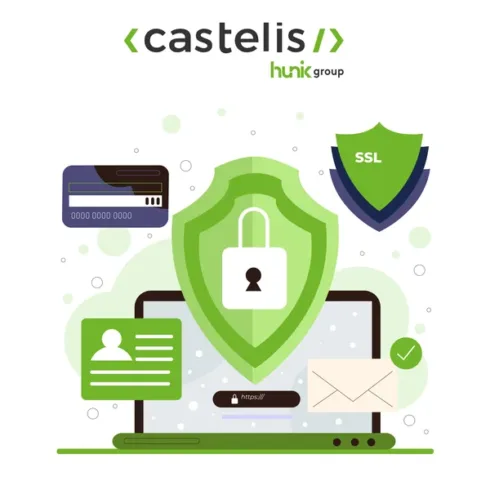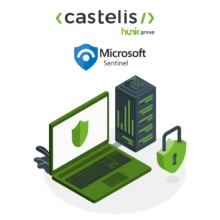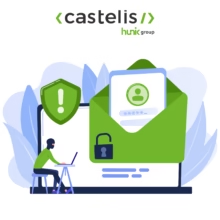
Configuring DMARC for Office 365: A How-To Guide
The security of emails is a crucial issue for companies using Microsoft 365. DMARC (Domain-based Message Authentication, Reporting & Conformance) is a protocol that allows you to authenticate emails sent from your domain and prevent identity spoofing (phishing). This detailed guide will explain how to configure DMARC for Office 365 to secure your communications and protect your domain from misuse.
What is DMARC?
Definition and How It Works
DMARC is an email validation protocol that relies on SPF (Sender Policy Framework) and DKIM (DomainKeys Identified Mail) to authenticate messages sent from a specific domain. It allows administrators to define rules on how to handle non-compliant emails and provides detailed reports.
Differences Between SPF, DKIM, and DMARC
- SPF: Verifies if the sender of an email is authorized to send messages on behalf of the domain.
- DKIM: Adds a cryptographic signature to each email to ensure its authenticity.
- DMARC: Applies a policy based on SPF and DKIM results and provides analysis reports.
Test your SPF, DKIM, and DMARC records for free to see where you stand.
Why Configure DMARC for Office 365?
Benefits of DMARC for Office 365
Implementing DMARC on Office 365 offers several major advantages:
- Protection Against phishing and identity spoofing: DMARC prevents cybercriminals from sending fraudulent emails pretending to be your business. It enhances security by reducing the risk of targeted attacks such as Business Email Compromise (BEC).
- Improved Domain Reputation: A properly authenticated domain reduces the likelihood of its emails being marked as spam, thus improving the deliverability of legitimate emails.
- Proactive Monitoring: Through DMARC reports, administrators can detect and analyze attempts at identity spoofing or abuses related to their domain’s emails.
- Centralized Control and Management: DMARC allows businesses to have full visibility into their domain’s usage and better manage their email communication channels.
Risks of Not Using DMARC
Failing to configure DMARC exposes organizations to several risks:
- Vulnerability to Phishing Attacks: Cybercriminals can send emails using your domain, misleading your customers, partners, and employees.
- Loss of Credibility and Brand Image: Fraudulent emails sent in your name can damage your reputation and erode customer trust.
- Reduced Deliverability: Without DMARC, email providers may consider some of your emails suspicious, sending them directly to spam or blocking them altogether.
- Lack of Visibility on Abuses: Without DMARC reports, it is difficult to identify malicious sources exploiting your domain for fraudulent purposes.
In summary, configuring DMARC on Office 365 ensures optimal protection for outgoing emails while providing better management and monitoring of your business’s electronic communications.
Preliminary Steps
Before implementing DMARC, ensure that SPF and DKIM are properly configured.
- Check SPF: Add an SPF record to your DNS to define the authorized mail servers.
- Enable DKIM: Configure DKIM in Microsoft 365 Admin Center to sign outgoing emails.
- Access DNS Manager: Ensure you have access to your domain’s DNS configuration.
DMARC Configuration Guide for Office 365
Step 1: Access Microsoft 365 Admin Center
Log in to Microsoft 365 Admin Center.
Navigate to Settings > Domains.
Step 2: Create a DMARC DNS Record
Add the following DMARC record to your DNS manager:
_dmarc.yourdomain.com TXT “v=DMARC1; p=none; rua=mailto:[email protected]; ruf=mailto:[email protected]; fo=1”
Explanation of Parameters:
- v=DMARC1: Protocol version.
- p=none: Policy (can be none, quarantine, or reject).
- rua: Address for receiving aggregate reports.
- ruf: Address for receiving forensic reports.
- fo=1: Requests a detailed report in case of SPF or DKIM failure.
Choosing a DMARC Policy: none, quarantine, or reject
- p=none: This policy is used to monitor emails without blocking those that fail authentication. Ideal for the initial testing phase.
- p=quarantine: Emails that fail authentication are sent to quarantine (spam folder). Suitable when you want to start applying restrictions without completely rejecting emails.
- p=reject: Completely blocks non-compliant emails. This is the strictest and most secure policy, recommended once you have tested and adjusted your configuration.
Step 3: Test and Validate Configuration
- Wait for DNS propagation (up to 48 hours).
- Use tools like DMARC Analyzer or MXToolbox to check your configuration.
- Analyze the first reports to adjust the policy if necessary.
Want to ensure your DMARC is correctly configured? Contact our experts for guidance.
Monitoring and Analyzing DMARC Reports
Understanding DMARC Reports
DMARC reports provide a detailed view of the authentication of emails sent from your domain. They help detect potential spoofing attempts and adjust your security policy.
- Aggregate Reports (RUA): These summarize the volume of sent emails, source IP addresses, and their compliance with DMARC rules. These reports provide a global view of domain activity.
- Forensic Reports (RUF): These provide details on each email that failed DMARC, SPF, and DKIM checks, helping to precisely identify spoofing attempts or misconfigurations.
Check out our recommendations for the best DMARC tools, including DMARC Advisor, for actionable reports.
Practical Tips for Effective DMARC Implementation for Office 365
- Start with p=none: This allows you to analyze reports without impacting deliverability and identify legitimate sending sources.
- Gradually move to quarantine then reject: Once all legitimate emails are properly authenticated, progressively strengthen the policy.
- Use a DMARC Reporting Service: Since DMARC reports can be complex, it is recommended to use tools like DMARC Advisor, DMARC Analyzer, PowerDMARC, or Google Postmaster Tools.
- Test DMARC records before going live: Tools like MXToolbox help verify record validity before applying them.
- Regularly analyze reports: Continuous monitoring helps identify configuration errors and spoofing attempts.
- Adapt configuration for subdomains: Specify a separate policy for subdomains if needed, using the sp parameter.
Conclusion
Configuring DMARC on Office 365 is a critical step to strengthen email security and protect your domain from spoofing. By following this guide, you will be able to implement DMARC effectively, monitor its impact, and adjust your policy to ensure optimal protection.
👉 Need help? Our cybersecurity team is here for you.
Voir plus de Actualités

Why Microsoft Sentinel is Essential for Cyber Threat Management: A Practical Guide for CIOs

Top best practices to improve email security with DMARC

Cloudflare Zaraz Guide: Manage your third-party scripts at the Edge for better web performance
